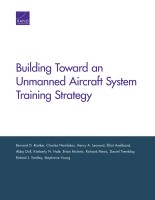| 来源类型 | Research Reports
|
| 规范类型 | 报告
|
| ISBN | 9780833085313
|
| 来源ID | RR-440-OSD
|
| Building Toward an Unmanned Aircraft System Training Strategy |
| Bernard Rostker; Charles Nemfakos; Henry A. Leonard; Elliot Axelband; Abby Doll; Kimberly N. Hale; Brian McInnis; Richard Mesic; Daniel Tremblay; Roland J. Yardley; et al.
|
| 发表日期 | 2014
|
| 出版年 | 2014
|
| 页码 | 116
|
| 语种 | 英语
|
| 结论 |
Each Service Needs to Resolve its Own Training Problems First- At this time, DoD should encourage each service to solve its own UAS training problems, incorporating the agreed multiservice tactics, techniques, and procedures.
Services Need to Address Qualification Levels- Army trainers have indicated that Army units are better at maintaining operator qualification for Shadows than for Ravens. Nevertheless, some units have trouble maintaining high qualification rates — some units have arrived at the NTC with one-half or fewer of their operators qualified.
Range and Beddown Space is an Issue- DoD should support current and future programs to develop more ranges and beddown and support facilities similar to those in the Army's current programs.
- As multiservice training in the employment of UAS capabilities becomes more of a priority, the Air Force's current basing and beddown posture will become a problem. The Air Force could consider the location of Army training bases when choosing where to base its UAS fleet. Another possibility is deploying Air Force UASs and their supporting ground and launch-and-recovery elements to Army and Marine Corps training centers — essentially, the approach used now to deploy UASs for operations in theater.
Simulators Should Not Be a Priority at this Time- Given current budget limitations, the current state of UAS simulator technology, the importance of fully developing the opportunities for live training, and the relatively low cost of such training, diverting funds to a research and development program to develop combat simulators would seem to be unwise at this time.
|
| 摘要 |
- Promulgate a training strategy focused on preparing operational forces to capitalize on UAS capabilities, built on a foundation of home station training as a prerequisite for multiservice interoperability training at the major maneuver training centers.
- Support the services in building out the training infrastructure at home station.
- Undertake a full cost and effectiveness analysis before proceeding on any investment for new UAS simulators.
|
| 主题 | Military Education and Training
; Military Tactics
|
| URL | https://www.rand.org/pubs/research_reports/RR440.html
|
| 来源智库 | RAND Corporation (United States)
|
| 资源类型 | 智库出版物
|
| 条目标识符 | http://119.78.100.153/handle/2XGU8XDN/107842
|
推荐引用方式
GB/T 7714 |
Bernard Rostker,Charles Nemfakos,Henry A. Leonard,et al. Building Toward an Unmanned Aircraft System Training Strategy. 2014.
|
|
文件名:
|
x1495316371654.jpg
|
|
格式:
|
JPEG
|

|
文件名:
|
RAND_RR440.pdf
|
|
格式:
|
Adobe PDF
|
除非特别说明,本系统中所有内容都受版权保护,并保留所有权利。